
16
2
Video Output Connector
If you would like to connect your video source to another device, you can use the Video Output BNC
connectors.
Note: The Video Output BNC connectors are auto terminated. Do NOT connect a cable to the Video
Output BNC unless it is connected to a terminated device because it will cause poor quality
video.
3
Audio Input/Output Connector
Your recorder can record audio from up to four sources. Connect the audio sources to
Audio Input Connectors 1 to 4 as needed using RCA jacks. Connect Audio Out to your
amplifier.
Note: It is the user’s responsibility to determine if local laws and regulations permit recording audio.
The recorder does not have amplified audio output, so you will need a speaker with an amplifier.
The recorder does not have a pre-amplifier for audio input, so the audio input should be from an
amplified source, not directly from a microphone.
4
Maintenance (eSATA) Port
Use this port to perform maintenance operations. Do not use for normal operation.
5
Alarm Input/Output Terminal
Note: To make connections on the Alarm Terminal Strip, press and hold the button and insert the wire
in the hole below the button. After releasing the button, tug gently on the wire to make certain
it is connected. To disconnect a wire, press and hold the button above the wire and pull out the
wire.
[AI1] to [AI8] (Alarm Input):
You can use external devices to signal the recorder to react to events.
Mechanical or electrical switches can be wired to the [AI] (Alarm Input) and [GND] (Ground) terminals. The
threshold voltage of electrical switches for [NC] (Normally Closed) is above 2.4 V and for [NO] (Normally
Open) is below 0.3 V, and should be stable at least 0.5 seconds to be detected. The voltage range of alarm
input is from 0 V to 5 V. See “Chapter 3 ─ Configuration” for configuring alarm input.
[GND] (Ground):
Connect the ground side of the Alarm input and/or alarm output to the [GND] terminal.
Note: All the connectors marked [GND] are common.
















































